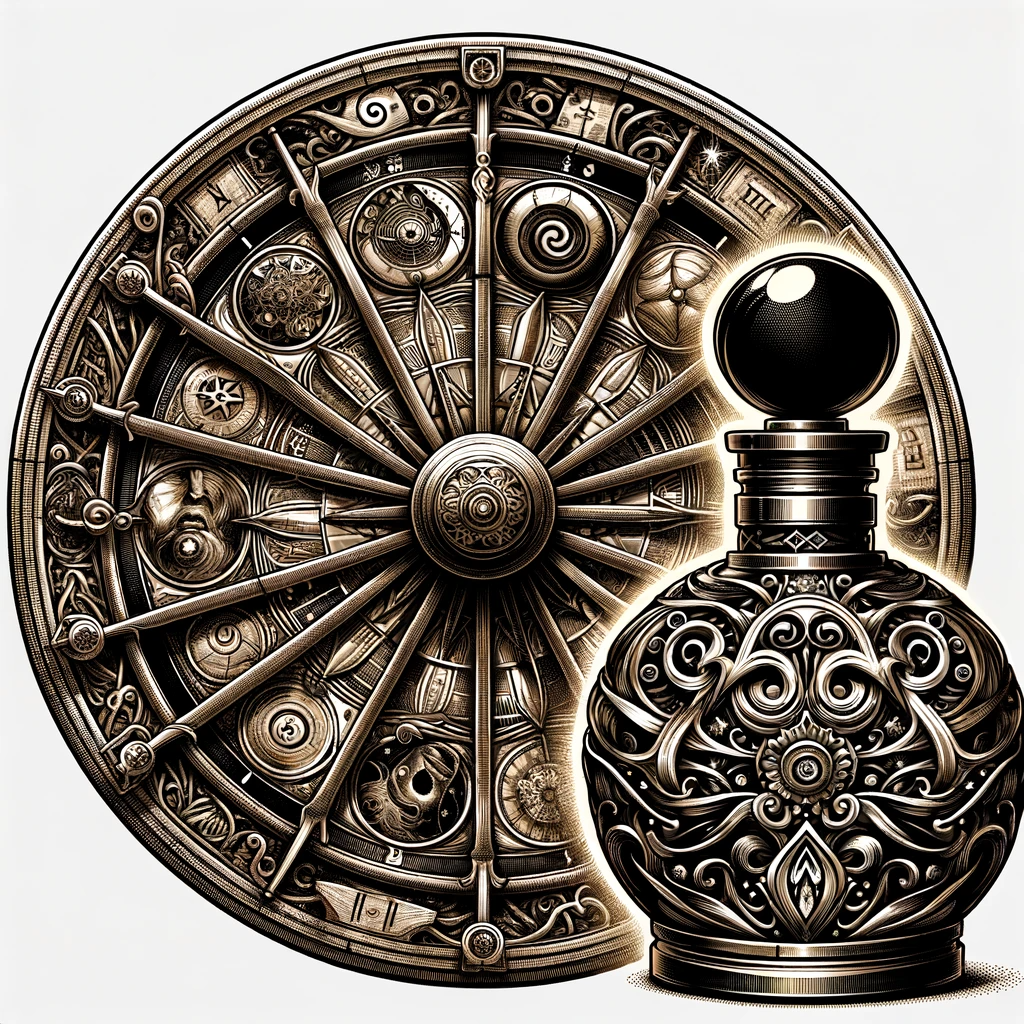
Mastering the Fragrance Wheel: A Comprehensive Guide to Perfume Classification
Find out why Fragrance Wheel is so important to discover your signature scent!
Have you ever found yourself lost in a maze of scents, where each twist and turn brings you to an intoxicating new blend?
How do the scent pieces come together in a complex blend of perfumes? The rollercoaster adventure with the Fragrance Wheel begins here at Chez Pierre.
You know that moment when a fragrance hits you, and suddenly you're traveling through time, standing in your grandmother’s garden, surrounded by blooming roses and freshly mowed lawn?
Yeah, the perfume notes can be so powerful that they invoke the deepest memories of your soul.
We stood dazed in front of shelves lined with elegant bottles, wondering which one whispered our name. It feels almost magical how some can transport us while others leave no mark.
Stick around because we're about to decode this aromatic enigma behind the Fragrance Wheel and you’ll discover why certain perfumes feel like they were made just for you.

Diversity of Perfume Notes
What Is a Fragrance Wheel?
A fragrance wheel is an innovative tool used in perfumery to classify and visualize the relationship between different scent families, such as floral, oriental, woody, and fresh. Each of these categories is then further subdivided. For example, Floral might include subcategories like Fruity Florals or Soft Florals.
Developed by experts like Austrian perfumer Paul Jellinek and later refined by Michael Edwards, the perfume scent wheel serves as a guide for understanding the complex world of fragrances and their compositions.
Each segment of the scent wheel represents a distinct family of scents, providing a framework for identifying and combining aromas in perfume creation, from delicate florals to deep, earthy notes.
The fragrance wheel not only aids perfumers in crafting balanced and appealing scents but also helps consumers select fragrances that align with their personal preferences and olfactory experiences.
As an essential reference in the perfume industry, the fragrance wheel highlights the diversity and intricacy of scents, making it a fundamental tool for both professionals and enthusiasts in exploring various types of cologne scents.
It may represent a circular diagram for sniffing out what tickles your fancy in the world of olfactory families.
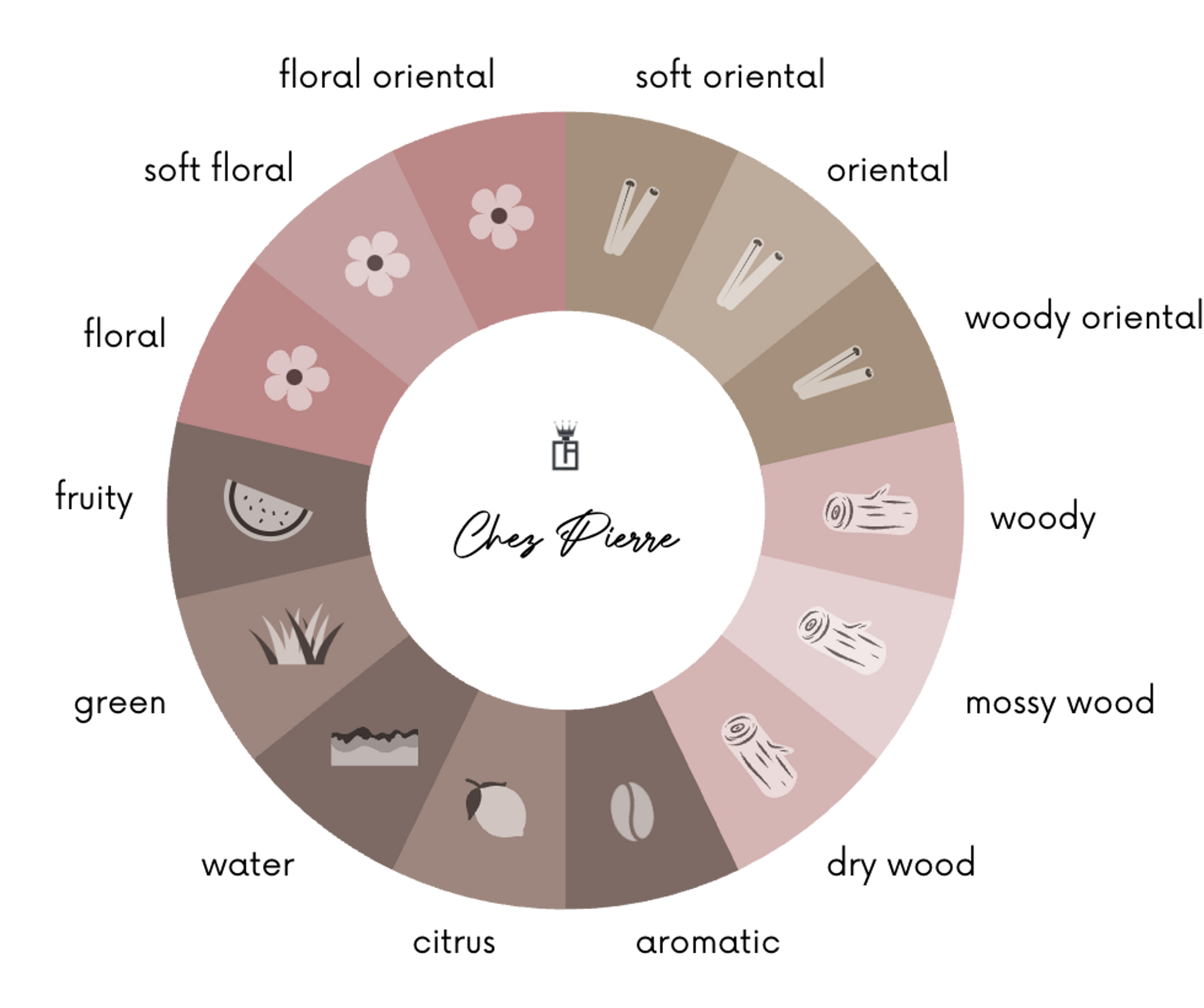
Fragrance Wheel
The Circular Diagram of Scents
The circular layout of the Fragrance wheel helps in visualizing how different fragrance families relate to each other. Scents that are neighbors on the wheel are more likely to have similar characteristics. For instance, Oriental and Woody fragrances often share a certain richness and depth.
The Fragrance wheel also demonstrates how fragrance notes can transition or blend into one another. A scent that sits between Floral and Oriental may have the lightness of florals but with a hint of the exotic richness typical of Oriental fragrances.
Consider a fragrance that is primarily categorized in the Floral family but leans towards the Fresh side of the scent wheel. This fragrance might have a dominant note of rose or jasmine (Floral) but is complemented by undertones of citrus or green notes (Fresh), creating a scent that is both flowery and vibrant. The proximity of the Floral and Fresh families on the scent wheel indicates this harmonious blend.

Perfume classification circulation
The Origins of Fragrance Wheel
It's 1949, and the fragrance world is about to be spun on its head. Austrian perfumer Paul Jellinek crafts a revolutionary tool that reshapes how we perceive scents. this concept was later refined in his book "The Practice of Modern Perfumery".
The Fragrance Wheel, also known as the aroma wheel, perfume wheel, or smell wheel, is an ingenious classification tool that organizes cologne scent profiles into various fragrance families.
A Fragrance Wheel is an innovative tool that serves as a visual representation of how fragrances relate to each other, much like a color wheel in the art world. It's a staple in understanding the complex world of scents, helping both novices and experts navigate through diverse olfactory families.
The genius behind his design lies in its simplicity yet complexity—it reflects conventional fragrances that were well-loved back then while remaining relevant even as trends shift like sands in the desert winds.
However, it was Michael Edwards, a renowned figure in the fragrance industry, who revolutionized this concept. Edwards's fragrance wheel, introduced in his seminal work "Fragrances of the World", offers a comprehensive guide to scent circle examples of formulations, classifying fragrances into Fresh, Crisp, Classical, and Rich compositions. His approach to fragrance classification has been widely adopted, influencing how perfumes are categorized and understood.
Scent Families in Fragrance Wheel
Imagine the fragrance wheel as a painter's color palette, but instead of hues for your canvas, you've got aromas to paint your personal scent story. The 4 main categories—floral, oriental, woody, and fresh—are like the primary colors of olfaction.
Scent families in perfumery are broad classifications that organize perfumes based on their dominant character or underlying accord. These fragrance families are a way to describe and understand the overarching feel or theme of a fragrance, rather than focusing on the specific fragrance notes that make up its composition.
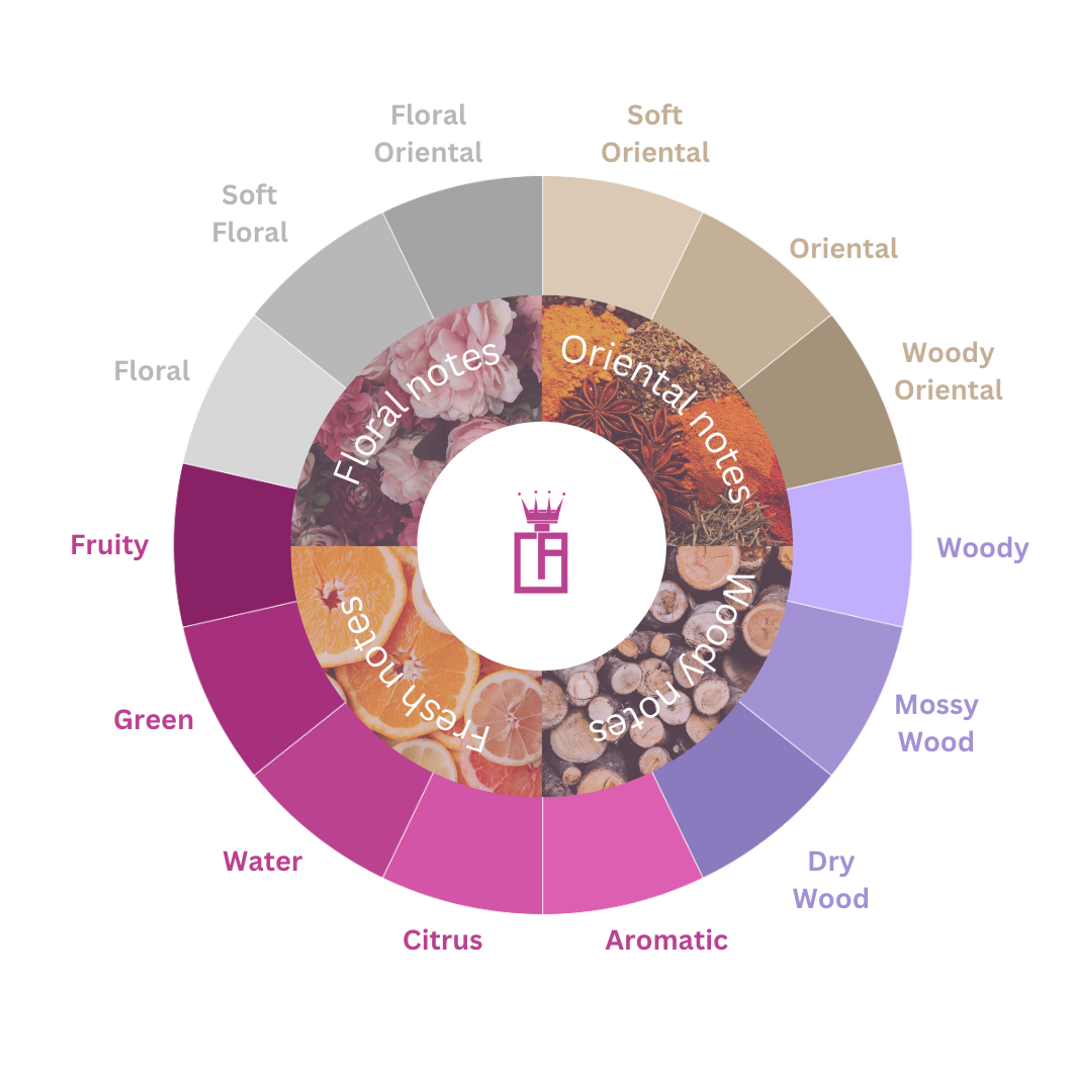
The 4 Main Scent Families on the Fragrance Wheel and Their Subcategories
Floral Scent Familly
Floral notes are often at the heart of a perfume, forming the middle or 'heart' notes. They can range from the singular scent of a rose to complex bouquets that bring together various floral elements.
The floral family is like walking through a blooming garden with every step. It groups scents that range from single flowers—think roses and jasmine—to complex bouquets where different notes are woven together to create something greater than their parts.
Floral fragrances can evoke memories of freshly cut flowers or even an airier impression akin to the soft powdery notes floral perfumes often carry.
If you prefer scents that remind you of bright lily petals or delicate orange blossom whispers in springtime air, then this luxurious fragrance family might just be calling out to you.
Each subfamily in the fragrance wheel adds another layer; whether it's blending floral with some green category freshness or enriching them with sweet spices—a technique reminiscent of fine wine aroma wheels which also categorize based on nuanced characteristics.
Floral notes are an experience, from the uplifting zest of orange blossom to the refined elegance of powdery notes and the vivid freshness of cut flowers. They transport you to sunlit gardens and intimate moments with their complex yet familiar aromas.

Floral Perfume Family
The popular Floral subcategories of the Fragrance wheel:
- Single Floral Accords: Here a single flower is a dominant note. As we explained in the Types of Perfumes, the perfume's composition is designed to highlight the unique characteristics of that flower. They can include roses, lilies, or gardenias.
- Floral Bouquet Accords: This represents the complexity and richness of a bouquet of floral notes. It could involve several types of roses, or a mix of different flowers such as jasmine, lily of the valley, and carnation.
- Fruity Floral Accords: The sweetness or tartness of fruit can either complement the floral note or provide a pleasant contrast. You may combine a peony note with peach, or a rose note mixed with black currant.
- Green Floral Accords: It creates the impression of a flower in its natural setting, complete with green leaves, stems, and perhaps a hint of dew. For instance, you might have a gardenia note combined with the scent of green leaves.
Oriental Scent Family
The oriental family, also known as the amber family, is marked by its rich, sensual character. It includes notes of spices, resins, and woods, often complemented by sweetness like vanilla. The Middle East is their first association having a luxurious, mystic, and seductive quality.
Oriental scents evoke exoticism and warmth, offering depth and intensity. They are perfect for those who prefer a strong, lingering presence that makes a statement.
Diving into oriental fragrances feels like wrapping yourself in a warm velvet cloak spiced with cardamom and cinnamon hints at dusk—the kind of warmth that promises stories by firelight.
These rich blends share characteristics: they're all about deep amber dry tones mixed up with creamy sandalwood backdrops, sometimes hinting at smoky notes trailing behind them.
This scent family includes concoctions perfect for someone who loves feeling enveloped by their perfume long after they've left the room—it clings gently yet persistently, much like mystery itself tends to do.
The heart of many oriental aromas is sweet spices like cardamom, cinnamon, and vanilla.
Amber gives off that golden glow sensation—it’s both radiant and deep with its resinous quality resembling ancient incense rituals from far-off temples hidden within mountain mists.
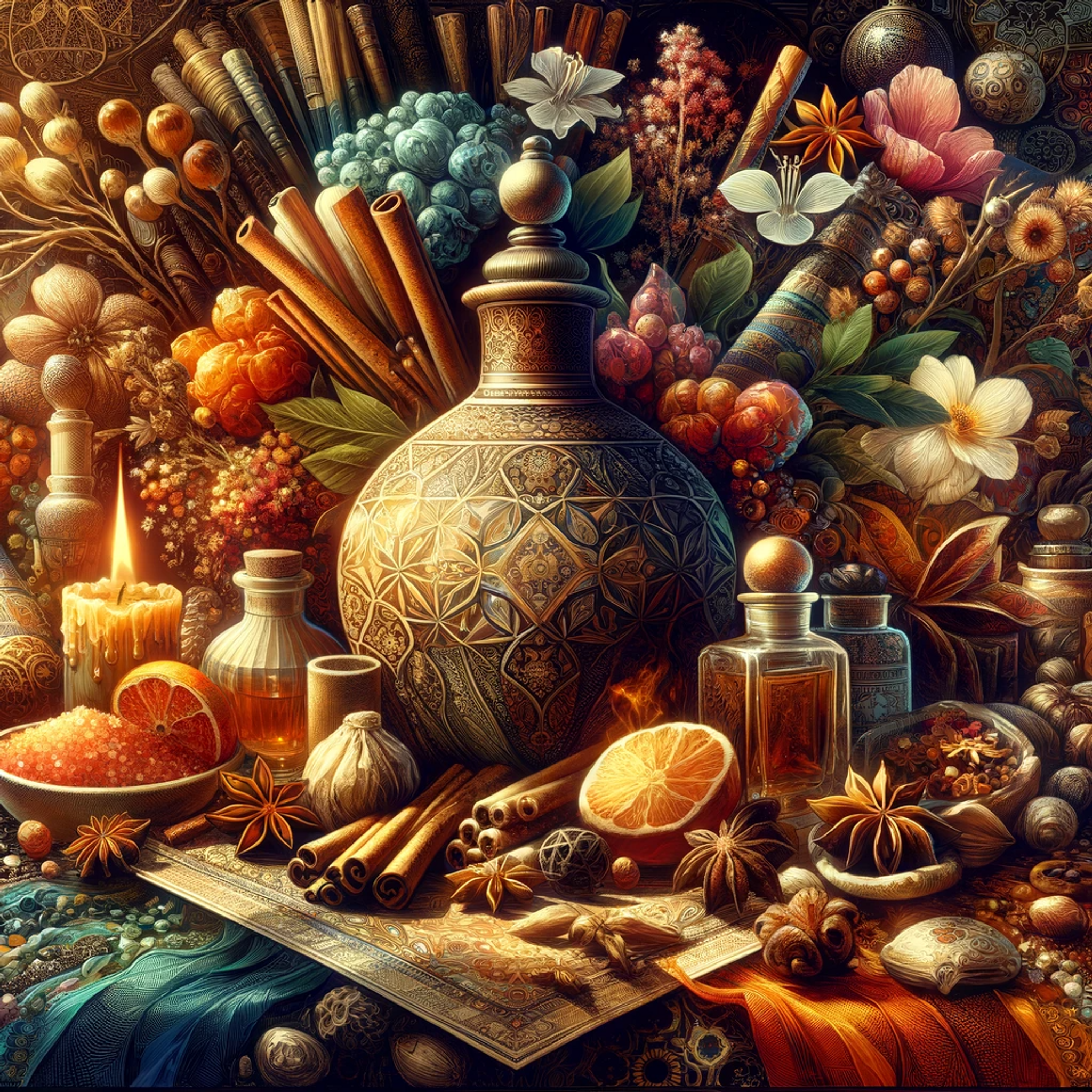
Oriental Scent Family
Most Wanted Oriental Subcategories of Fragrance Wheel
- Spicy Oriental Notes: Involves warm spices like cinnamon, clove, nutmeg, or cardamom. It will remind you of distant exotic markets, spicy foods, or holiday treats.
- Sweet Oriental Notes: Accords such as vanilla, tonka bean, or amber can create a sense of warmth and comfort, often associated with desserts or baked goods.
- Resinous Oriental Notes: Enter an ancient temple and attend a far-distant religious ceremony. Resinous notes, such as frankincense, myrrh, or benzoin, will open rich, deep character adding a veil of mystery.
Woody Oriental Notes: A combination of the luxury of Oriental elements with the earthiness of woods will add a sense of depth and complexity to the perfume.
Woody Scent Family
Woody fragrances are characterized by their dry, warm, and earthy notes. This family includes scents like cedarwood, sandalwood, and vetiver, often paired with mossy and leather accents. Woody scents can range from the light, aromatic freshness of bamboo and green leaves to the deep, resinous richness of oud and palo santo.
The woody category beckons those who crave earthy authenticity—you know what I mean if cedarwood makes you think not just trees but pencil shavings from third-grade art class too. Woody ambery undertones are grounded yet full-bodied; they capture essences ranging from mossy woods dampened by morning dew to leather aromatic sophistication fit for any occasion demanding gravitas.
Modern perfumery techniques akin to strategic scent placement within compositions allow these natural elements—from forest floor richness over freshly mowed lawn zestiness—to come alive uniquely on everyone’s skin thus crafting truly personal experiences each time-worn.
These fragrances are like a hike through an ancient forest, with each breath revealing layers of earthy tones that seem to whisper tales from centuries past.
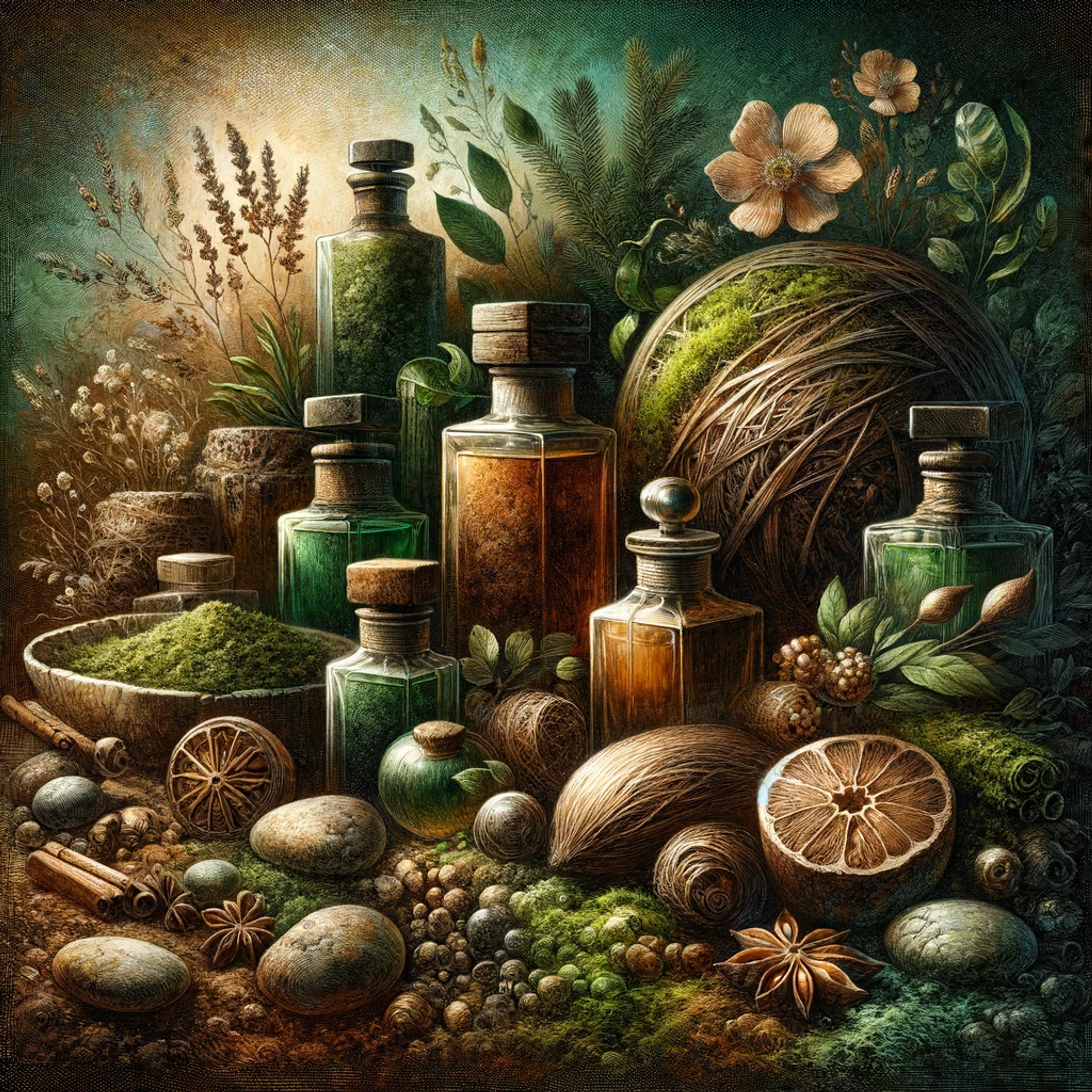
Woody Scent Family
The Best Woody Subcategories of Fragrance Wheel
- Soft Woody Notes: Lighter, softer woods such as cedar, sandalwood, or bamboo. The dominant sense of calm and tranquility in a perfume, and transports you to a peaceful forest or a crafted wooden object.
- Heavy Woody Notes: Deeper, more intense woods such as mahogany, oak, or oud. You might think of a classic library or a luxurious piece of furniture.
- Smoky Woody Notes: As we explained in the Types of Perfumes, they might remind you of a campfire, a burnt log, or a leather jacket. Deriving from notes like birch or cade contributes to a sense of mystery or masculinity in a fragrance.
- Green Woody Notes: This can create the impression of a living tree, complete with leaves and sap. You might have a pine or spruce note or a cedar note combined with a fresh grassy element.
Fresh Fragrance Family
Fresh family smells exactly how one would imagine crispness personified. Imagine citrus rinds zested just moments ago, their scent mingling harmoniously with aquatic notes that capture the essence of ocean spray.
This balance is set against a lush backdrop of green leaves, evoking feelings of being surrounded by nature's freshness at every turn.
It includes sub-families like citrus, with zesty notes of lemon, bergamot, and mandarin, and green notes reminiscent of fresh-cut grass and cucumber.
Aquatic sub-notes bring in the freshness of the ocean, with sea salt and ozone elements. This family is perfect for those who enjoy light, refreshing fragrances that evoke a sense of cleanliness and vitality.
Fresh fragrances whisk you away to a world of citrus orchards and serene lakes, offering a burst of crispness that's as invigorating as nature itself.
With layers of green leaves, aquatic notes, and vibrant flowers, these scents are your go-to for evoking cleanliness without overpowering subtlety- perfect for making any moment feel more alive.

Fresh Scent Family
Top Fresh sub-families of fragrance wheel:
- Soft Woody Notes: Lighter, softer woods such as cedar, sandalwood, or bamboo. The dominant sense of calm and tranquility in a perfume, and transports you to a peaceful forest or a crafted wooden object.
- Heavy Woody Notes: Deeper, more intense woods such as mahogany, oak, or oud. You might think of a classic library or a luxurious piece of furniture.
- Smoky Woody Notes: They might remind you of a campfire, a burnt log, or a leather jacket. Deriving from notes like birch or cade contributes to a sense of mystery or masculinity in a fragrance.
- Green Woody Notes: This can create the impression of a living tree, complete with leaves and sap. You might have a pine or spruce note or a cedar note combined with a fresh grassy element.
How Does Fragrance Wheel Help Us to Understand Perfume Notes?
The fragrance wheel helps in understanding which notes fall under which category. For example, a perfume with a predominant floral top note may have sub-notes from the floral category of the perfume wheel.
It also aids in blending scents.
By understanding the fragrance categories in parfum chart, perfumers can create balanced and harmonious scents by combining notes from complementary categories.
The wheel provides a visual guide for categorizing scents, which can be particularly helpful for individuals selecting a perfume.
It helps in predicting how different scent profiles might interact and what kind of olfactory experience to expect.
For perfume classification, we often use the fragrance wheel as a guide to create new and complex fragrances. Mixing perfume notes from different parts of the scent wheel develops unique and layered scents. It may also help to find out which kind of fragrances can last longer on your skin and have better projection.
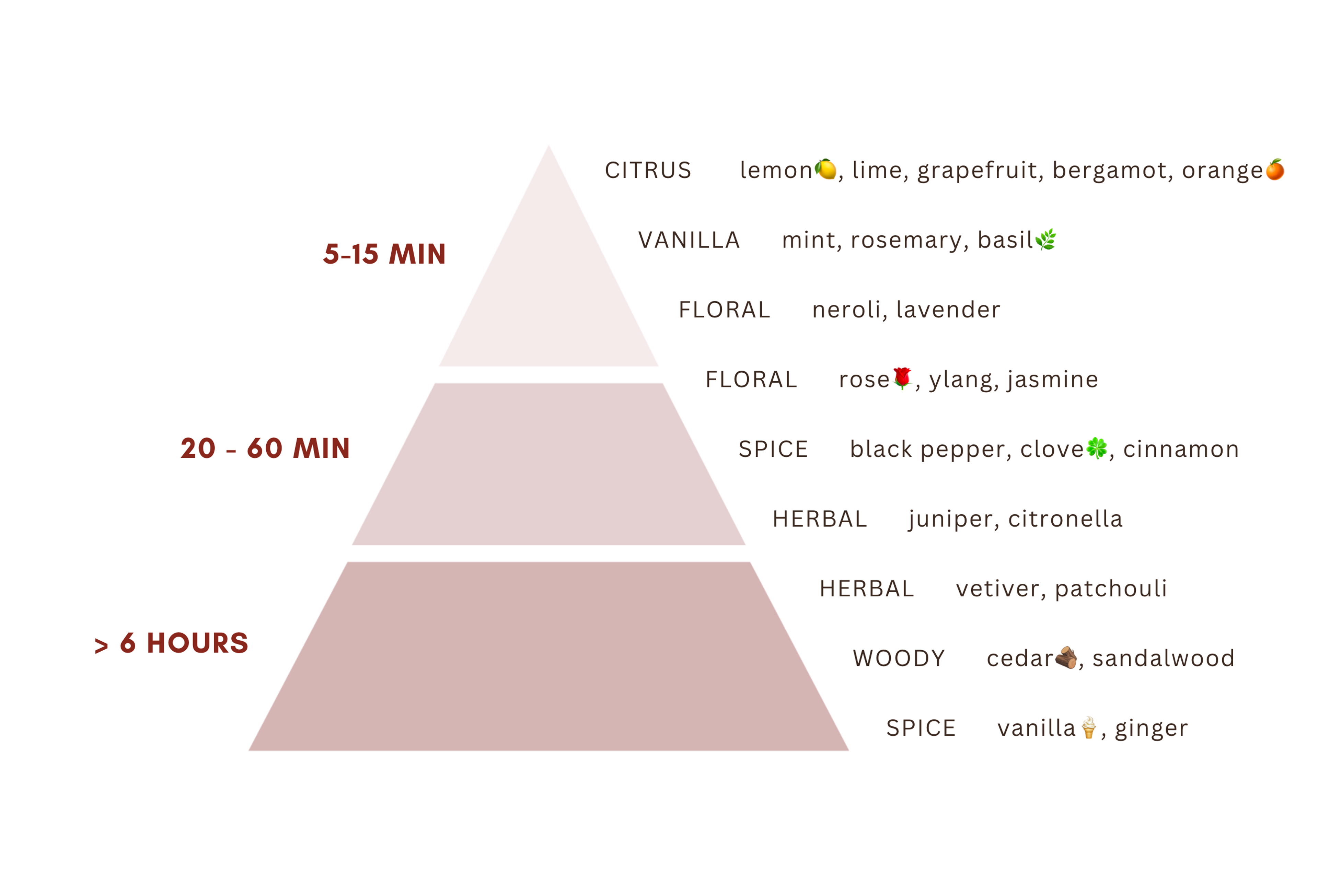
Olfactory Pyramid Notes Classification
Top Notes: The Opening Act
Top notes are the first scents you perceive when you smell a fragrance. They are usually light, volatile aromas that evaporate quickly.
On the Fragrance Wheel, top notes often determine the initial category a fragrance might seem to belong to. For instance, a perfume with citrus top notes might initially be perceived as part of the 'Fresh' family.
Middle Notes: The Heart of the Perfume
Middle or heart notes emerge just as the top notes dissipate. They are considered the heart of the fragrance and are usually more rounded and complex.
These notes can influence a shift in how the fragrance is categorized on the scent wheel. For example, a scent with a citrusy top note might evolve into a floral heart, moving the perception from 'Fresh' to 'Floral'.
Think hours instead of minutes—and evolve as time passes.
Base Notes: The Grand Finale
Base notes are the longest-lasting scents in a fragrance and provide depth and solidity. They're typically rich and heavy hitters that give perfumes depth and staying power—you'll catch whiffs hours after application if not well into the next day.
The base notes can significantly affect the final categorization of a fragrance on the wheel. A perfume might start fresh, move through floral, and finally settle into a woody or oriental base, indicating its position on the wheel.
The transition from top to middle to base notes can create a complex scent profile that spans multiple families on the Fragrance Wheel. A fragrance might not fit neatly into a single category but instead may bridge several, depending on the combination and progression of its notes.
Important Tips When Using The Fragrance Wheel
Mastering the art of scent placement is like being a DJ for your nose—it's all about hitting the right notes at the perfect time. But before you can start spinning that olfactory vinyl, you need to know your music or in this case, different types of scents that suit you. That’s where the fragrance wheel spins into action.
Each section of the smell wheel, from fresh fragrances to deep woody ambery aromas, has its own vibe and ideal 'spotlight' moment throughout your day or event.
The beauty behind these color categories lies in their power to help perfume lovers blend floral with spicy notes seamlessly—a bit like creating a smoothie from flavors that share characteristics across different parts of our circular diagram friend.
You could mix orange blossom undercurrents with powdery notes of floral whispers; imagine pairing up cut flowers' innocence with sweet spices’ sassiness—it's daring yet harmonious.
Your unique concoction will be more than just another smell; it'll tell people who are sniffing around exactly who they’re dealing with—and trust me, getting tagged as ‘the one who always smells amazing’ is not too shabby at all.
Avoid Overwhelming by Simplifying Choices
Outward slowly exploring adjoining territories within the same sector before diving cross-wheel adventures into unknown lands amber dry or smoky realms oriental allure offers us curious noses out there. Start with familiar scent categories, then explore adjoining ones to craft a unique blend that tells your story without overwhelming your senses.
How to Use the Fragrance Wheel
First off, know yourself. Are freshly cut flowers what get your olfactory senses dancing? Or does the thought of green leaves after a freshly mowed lawn send shivers down your spine? Your preferences are clues—follow them.
Explore the fragrance wheel to sniff out new favorites or create your signature scent—let it guide you through floral bouquets, oriental spice markets, woody forests, and fresh havens. Know what scent types thrill you? Follow those clues and dive into a world of perfume dupes where peppery roses meet creamy sandalwood and zesty lemons blend with earthy vetiver.
FAQ
1. What is the fragrance wheel method?
The fragrance wheel method is a system used to categorize and visualize different perfume scents. It organizes fragrances into distinct families such as Floral, Oriental, Woody, and Fresh, and shows the relationships and transitions between these scent categories. This method aids in understanding and creating perfumes by grouping similar aromas and providing a framework for scent classification.
2. Who invented the fragrance wheel?
The modern fragrance wheel was popularized by Michael Edwards, a fragrance expert. His version of the fragrance wheel was first introduced in 1983 and has since become a standard in the perfume industry. However, the concept of categorizing scents in a wheel-like diagram dates back earlier, with contributions from perfumers like Austrian Paul Jellinek.
3. Where does Musk fall on the fragrance wheel?
Musk is typically categorized under the Oriental family on the fragrance wheel. It is known for its warm, sensual, and sometimes animalistic qualities. Musk can be found in both natural and synthetic forms and is often used as a base note in perfumes, providing depth and a lasting foundation to the fragrance.